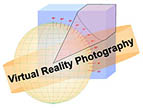

![]() Ask the VR Photography Experts
Ask the VR Photography Experts
![]()
Q: Is there significant advantage to shooting panoramas on film instead of with the latest digital cameras. I’ve heard that 35mm film has no better resolution (in lines per mm) than my new Canon 1D, and I am seeing quite a difference in sharpness of my digital pictures compared with my older 35mm film images. Is there any resolution or sharpness difference between shooting on film and scanning, instead of shooting digitally from the outset?
![]()
September, 2003
A: While this seems like it would be a simple comparison, it actually is somewhat complicated because of the vast differences between various films, as well as the variations between optical systems and digital sensors themselves.
"Sharpness" of a film is usually measured by its ability to resolve the difference between light and dark lines of varying size. The smaller the contrasting lines and spaces that can be resolved, the greater the resolving power (resolution). Thus lines/mm (or lines of resolution) are used as a primary measure of a film's potential sharpness. (Note that other factors influence "perceived sharpness" including granularity, contrast and even viewing methods. There will be a difference in both perceived and measured sharpness depending on whether the image is front lit vs. back lit, viewed as a glossy or matte print, etc.) There are many other factors that are involved in "sharpness" of an image as well, including shutter speed and movement during exposure, lens aperture, focal length, depth of field and even contrast.
Actual resolving power itself is influenced by a number of factors beyond a film's resolution. Camera lens, printing material, projection optics & screen texture, scanner optics & sensor limitations, monitor or display resolution, etc. all play a part in the result. For example, if a lens with a resolving power of 200 lines/mm is used with film resolving 50 lines/mm, the combined resolving power is only 40 lines/mm.
| (The formula is 1/R = 1/r1 + 1/r2 + 1/r3... where R equals total resolving power and each r represents the respective resolving power of the components.) |
![]()
For the sake of illustration, let's consider as examples Fuji 35mm films. Their resolving powers are published in the Fuji Professional Data Guide.
Fujicolor Reala and Superia 100 both have resolving powers of 63 lines/mm or 125 lines/mm when shot against low low high contrast resolution targets respectively. Fuji Velvia is a widely acclaimed "sharp" slide film with 80 lines/mm resolution against a low contrast target and 160 lines/mm against high contrast. From these, we can assign a range between 60 and 160 lines/mm to represent 35mm film resolution.
Converting this to a pixel or digital equivalent is a bit dicey, and requires certain assumptions that may not be technically accurate -- but in the interest of simplifying the concept, we'll proceed as follows.
A 35mm film frame is approximately 24mm x 36 mm. Thus, to get an approximate pixel equivalent you'd multiply 24mm x lines/mm x 36mm x lines/mm for equivalent data. (This is then multiplied by 3 for 8-bit RGB color to get the uncompressed file size for the resulting image.)
| Reala & Superia 100 |
| 24mm x 60 x 36mm x 60 = 3,110,400 pixels (equivalent) or about an 8.9 MB file |
| Velvia |
| 24mm x 160 x 36mm x 160 = 22,118,400 pixels (equivalent.) or about a 63.3 MB file |
Compare this to the advertised performance of professional digital cameras such as:
| Nikon D1x | (5,327,776 pixels) |
| Canon EOS 10D | (6,518,336 pixels) |
| Canon EOS 1Ds | (10,989.056 pixels) |
| Kodak DCS 14n | (13,898,880 pixels) |
While these cameras are now approaching the resolution capabilities of some films, they have not yet surpassed film in maximum resolution nor in other areas of performance.
![]()
However, much of this is probably moot to most VR photographers since we generally do not need this much resolution for either panoramic or object shooting. Most current VR software applications have memory and output size limitations, which make it difficult (and slow) to stitch a dozen 41 MB images together, such as those shot with Kodak’s DCS 14n.
Perhaps the best recent improvement to pro digital cameras is that some of them now have full-frame image sensors, meaning that panoramic VR photographers can finally take full advantage of the ultra-wide focal lengths of our existing lenses when shooting digitally.
However, one still has to deal with organizing, cataloging, storage and work flow in the digital world, which often require different systems than those we use for film. Also, there are archival concerns related to digital originals and whether future systems and software applications (20 or more years from now) will still be able to effectively handle today's proprietary digital camera formats.
Proprietary formats aside, many of us might think that today’s JPEG and TIFF formats will be around forever. We should however remember that an entire video industry thought the same thing about Betamax, 3/4” tape and a variety of other formats that are virtually non-existent today. In fifty years, it will probably still be fairly simple to scan a piece of film. Based on the history of the computer industry however, it may not even be possible to find a working drive to read today's CDs or DVDs then.
![]()
The good news is that today we at least have reasonable choices between shooting film vs. digital. Overall costs are close to being equivalent for many applications. However, making a complete switch to digital is still expensive, and goes far beyond the cost of simply purchasing a new camera.
For further information, see Technical Note: Film vs. Digital for Panoramic Capture
- Scott Highton